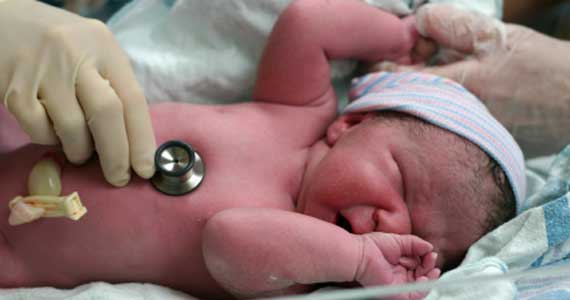Your Baby
Weeks 36 to 40
Your womb is getting tight around your baby now that she is plump. You may be able to see a foot or her buttocks on your abdomen. A full-term baby girl weighs about 7 pounds and is about 16 inches long. A baby boy weighs about 7 1/2 pounds and is about 20 inches long.
During the last week or so she will drop into your pelvis, called lightening, getting ready to be born. Her lungs have developed and she should be able to breathe on her own at 30 to 60 times each minute. You can breathe easier now because your lungs have more room.
Babies born at 40 weeks are not expected to have problems eating, breathing, or keeping a normal body temperature. Their chance of survival is almost 100 percent.
Your baby knows how to suck and swallow. Her lungs and stomach have developed. She’s ready to take her first breath and cry—“I’m Here!”

Every day counts. Every day on the inside is two less days in the nursery.All of your efforts to follow your doctor’s instructions and the guidelines in this booklet can help bring a healthy baby—one born as close to full-term as possible! Sadly, because there are still many things unknown about preterm births, they can’t always be prevented. But doing the following can give you confidence that you are doing the very best possible for your baby.
~ Remember how important it is for your baby to stay in your womb as long as possible. Every day counts. Every day on the inside is two less days in the nursery.
~ With your doctor, determine what your risk factors are for a preterm birth. Find out what preventive steps you should take.
~ Learn as much as possible about nutrition during pregnancy and follow those guidelines carefully.
~ Change lifestyle habits that could harm your baby.
~ Alter your physical activities as your doctor suggests.
~ Identify areas of stress. Practice ways to handle that stress.
~ Learn to identify uterine contractions and what activities cause them. Learn how to monitor contractions.
~ Develop a “plan of action” for when labor starts and you must go to the hospital.
~ Keep in close contact with your doctor. Don’t be afraid to ask questions. Use this booklet to help you prepare for your baby’s birth and to remind you of what to talk about with your doctor.
Above all, don’t let doing these things take away the joy of expecting your baby. Doing them can give your baby time to grow and develop so he can adjust to life outside your womb. The closer his birth comes to full-term, the sooner he will be able to eat, breathe, and maintain his body temperature on his own—and be able to come home. And that’s something to be excited about!
To Learn More about Preventing Preterm Birth
To Learn More about Caring for Your Newborn
Glossary
Amniotic Fluid: Fluid in the sac surrounding the fetus in the woman’s uterus.
Cervix: The lower, narrow end of the uterus.
Corticosteroid: Hormones given to mature fetal lungs, for arthritis, or other medical conditions.
Fetal Fibronectin: A protein produced during pregnancy.
Fetal Monitoring: A procedure in which instruments are used to record the heartbeat of the fetus and contractions of the mother’s uterus during labor.
Fetus: A baby growing in the woman’s uterus.
Placenta: Tissue that provides nourishment to and takes away waste from the fetus.
Prenatal Care: A program of care for a pregnant woman before the birth of her baby.
Progesterone: A female hormone that is produced in the ovaries and makes the lining of the uterus grow. When the level of progesterone decreases, menstruation occurs.
Tocolytic: Medication used to stop or slow preterm labor.
Ultrasonography: A test in which sound waves are used to examine internal structures. During pregnancy, it can be used to examine the fetus.
Uterus: A muscular organ located in the female abdomen that contains and nourishes the developing embryo and fetus during pregnancy.